Kingdom Plantae Family Arecaceae Tribe Cocoseae Scientific name Attalea Rank Genus | Order Arecales Subfamily Arecoideae Subtribe Attaleinae Higher classification Attaleinae | |
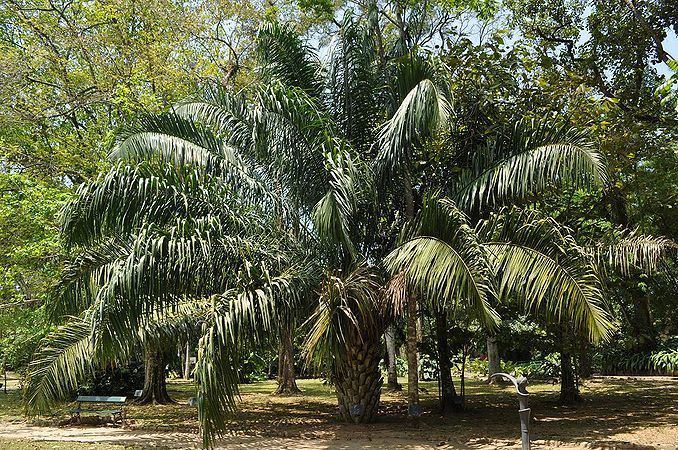 | ||
Lower classifications Attalea speciosa, Attalea maripa, Attalea cohune, Attalea oleifera, Attalea tessmannii | ||
Attalea is a large genus of palms native to Mexico, the Caribbean, Central and South America. This pinnately leaved, non-spiny genus includes both small palms lacking an aboveground stem and large trees. The genus has a complicated taxonomic history, and has often been split into four or five genera based on differences in the male flowers. Since the genera can only be distinguished on the basis of their male flowers, the existence of intermediate flower types and the existence of hybrids between different genera has been used as an argument for keeping them all in the same genus. This has been supported by a recent molecular phylogeny.
Contents
- Description
- Taxonomy
- History
- Species
- Reproduction and growth
- Distribution
- Habitat and ecology
- Uses
- References
Somewhere between 29 and 67 species are recognised in the genus, with estimates of as many as 100. Incomplete herbarium collections make it difficult to determine whether certain groups represent single species, or groups of similar species. Attalea species have a long history of human use, and include economically important sources of palm oil and fibre. Many species are fire tolerant and thrive in disturbed habitats. Their seeds are animal dispersed, including some which are thought to have been adapted for dispersal by now-extinct Pleistocene megafauna.
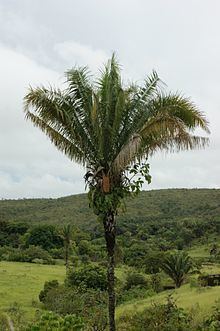
Description
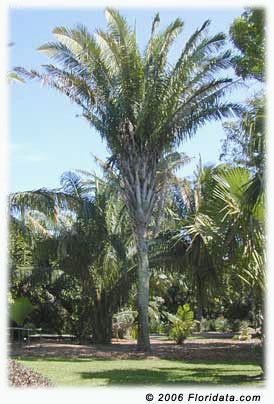
The genus Attalea has pinnately compound leaves—rows of leaflets emerge on either side of the axis of the leaf in a feather-like or fern-like pattern. Species are also non-spiny palms and includes both large trees with stout stems up to 30 metres (98 ft) tall and acaulescent palms (one which lack an aboveground stem). The number of leaves per individual varies from about three to thirty-five; larger plants tend to have more and longer leaves.
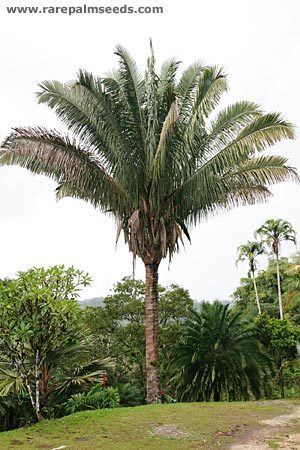
Inflorescences are large, branched and borne among the leaves. The inflorescence consists of a main axis—the peduncle and the rachis—and a series of smaller branches, the rachillae. The rachillae, which bear the flowers, emerge from the rachis. The peduncle is the main stalk, connecting the rachis with the stem. Inflorescences either consist entirely of male flowers, or are predominantly female with a few male flowers. Fruit usually have two or three seeds, although fewer or more are present in some species, and are usually brown, yellow, orange-brown or purple when mature.
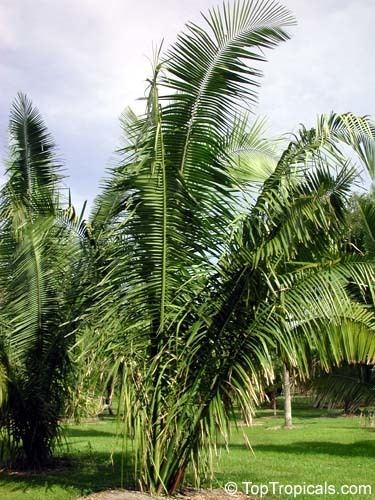
Four different types of male flowers exist. On the basis of these flower types, the genus has often been split into four genera—a more narrowly defined Attalea, Orbignya, Maximiliana and Scheelea. The species sometimes referred to Orbignya have coiled anthers, while the other groups have straight ones. The petals of those placed in Maximiliana are much shorter than the stamens, while those placed in Scheelea and a more narrowly defined Attalea have petals that are longer than the stamens. Five species do not fit easily into any of these groups; this fact has been used as an argument in favour of considering this group a single genus.
Taxonomy
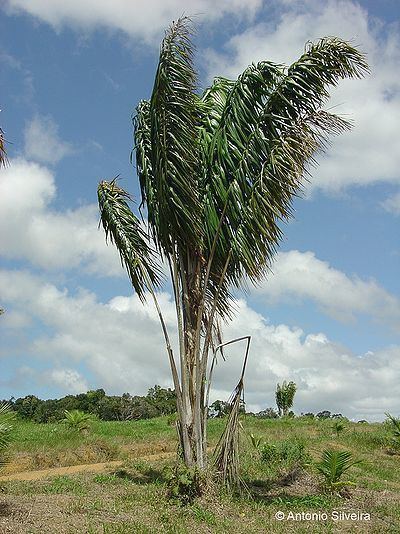
Attalea has been placed in the subfamily Arecoideae, the tribe Cocoseae and the subtribe Attaleinae, together with the genera Allagoptera, Beccariophoenix, Butia, Cocos, Jubaea, Jubaeopsis, Lytocaryum, Parajubaea, Syagrus and Voanioala. Within this subtribe, Attalea has been found to be a monophyletic group, and sister to the clade containing Allagoptera, Polyandrococos, Parajubaea, Butia and Jubaea.
Disagreement exists as to whether Attalea should be considered a single genus, or a group of related genera. In their 1996 Field Guide to the Palms of the Americas, Andrew Henderson, Gloria Galeano and Rodrigo Bernal combined all the species in the subtribe Attaleinae (as it was then defined) into a single genus, Attalea. In his 1999 Taxonomic Treatment of Palm Subtribe Attaleinae, American botanist Sidney F. Glassman divided the group into five genera—a more narrowly defined Attalea, Orbignya, Maximiliana, Scheelea and Ynesa. Rafäel Govaerts and John Dransfield recognised a single genus in their 2005 World Checklist of Palms, and Jean-Christophe Pintaud continued this usage in his 2008 review of the genus.
The multi-genus approach is based solely on the structure of the male flowers; no other characters could be consistently associated with one genus or another. Four of the genera—Attalea (in a narrow sense), Orbignya, Maximiliana and Scheelea—correspond to four different types of male flowers found within the genus. However, a few species have flowers that are intermediate between these four types, including A. colenda (which Glassman placed in its own genus, Ynesa) and this has been used as an argument for the single-genus approach. In addition, there are several hybrids between species that would be considered different genera under Glassman's five-genus system, which has also been used as an argument for placing them in a single genus. In 2009 Alan Meerow and colleagues published a molecular phylogeny of the subtribe which found that some species placed in Orbignya were actually more closely related to species placed in Scheelea than they were to other members of that genus (if the five-genus approach was used), while A. crassispatha, placed in Orbignya by Glassman, was actually a sister to both Scheelea and Orbignya.
History
The genus Attalea was first described Carl Sigismund Kunth in 1816 based on specimens collected by Alexander von Humboldt and Aimé Bonpland, although older, pre-Linnaean descriptions exist, including Charles Plumier's 1703 description of A. crassispatha. The genus was named for Attalus III Philometor, king of Pergamon, known for his interest in medicinal plants. The type species is A. amygdalina, a Colombian endemic. The genera Maximiliana and Orbignya were described by Carl Friedrich Philipp von Martius in 1826 and 1837 respectively. Scheelea was described by Hermann Karsten in 1857, and Ynesa by Orator F. Cook in 1942.
Species
Experts disagree about the number of species in the genus Attalea (broadly defined). In 1965, Dutch taxonomist Jan Gerard Wessels Boer estimated that there may be as many as 100 species in the genus. In their 1996 Field Guide to the Palms of the Americas Andrew Henderson and coauthors recognised 29 species in the genus, while Sidney Glassman recognised 65 species in his 1999 treatment of the group. Largely following Glassman's lead, Rafaël Govaerts and John Dransfield recognised 67 species in their 2005 World Checklist of Palms. An important element of this disagreement is the decision by Glassman to define species more narrowly than Henderson. As a result, what Henderson interpreted as variation within species, Glassman took as differences between morphologically similar species. This problem is complicated by the fact that many of these species are poorly represented in herbarium collections. The large size of the leaves, inflorescences and fruit of many Attalea species makes them difficult to collect. In addition, many important collections, including type specimen, have been lost or destroyed. Sparse or incomplete collections make it difficult to differentiate variation within a single species from variation between different species.
The three recent treatments (Henderson and coauthors, Glassman, and Govaerts and Dransfield) recognised a total of 73 species, but only 20 species are accepted by all of them. The remainder account for either nine species or more than 40. For example, what Andrew Henderson considered a single species, Attalea attaleoides, other authors have considered a species complex consisting of four or five species. Glassman doubted the validity of A. attaleoides as a species, and described four new species from material that had previously been attributed to A. attaleoides—A. camopiensis, A. degranvillei, A. guianensis and A. maripensis. Govaerts and Dransfield accepted both Glassman's four species and A. attaleoides. However, Jean-Christophe Pintaud was of the opinion that A. guianensis, A. maripensis and A. attaleoides were all very similar, and thought it likely that they all represented the same species.
Another species complex in Attalea includes A. speciosa and related species. Henderson (1995) recognised A. speciosa and A. spectabilis, considering the latter to either be an acaulescent form of A. speciosa or a hybrid between it and A. microcarpa. Govaerts and Dransfield accepted A. spectabilis, but Glassman considered it a dubious taxon. Attalea vitrivir was recognised as a distinct species by Michael Balick and coauthors; Glassman and Govaerts and Dransfield concurred, but Henderson considered it part of A. speciosa. Glassman also described a fourth member of this group, A. brejinhoensis, and it is accepted by Govaerts and Dransfield.
Reproduction and growth
Attalea species are monoecious—male and female flowers are separate, but are borne by the same plant. Various species have been described as being insect-pollinated, including A. phalerata, while pollination in A. colenda and A. speciosa, has been attributed both to insects and wind.
Seed germination is remote tubular—during germination, as the cotyledon expands it pushes the young shoot away from the seed. After germination, the stem initially grows downward before turning to grow upward and produce the aboveground stem. This produces a "saxophone shaped" belowground portion of the stem. The fact that the shoot tips of Attalea seedlings are underground it likely to contribute to their fire-tolerance.
Distribution
Species range across the Neotropics from Mexico in the north to Bolivia, Paraguay, and southern Brazil in the south. According to Govaerts and coauthors, three species are found in Mexico, four in Central America, and 62 in South America. Three species are present in the Caribbean—two in Trinidad and Tobago, along the southern edge of the region, and one in Haiti.
Habitat and ecology
Attalea includes both large trees and small acaulescent palms which occupy a number of different ecological niches. Dense stands of some of the larger species are conspicuous elements on the landscape, while smaller species are found in both in the forest understorey and in savannas.
Disturbance has been implicated in the formation of vegetation dominated by large Attalea species. In seasonally dry Amazonian forests the density of large adult A. maripa palms was correlated with canopy openness; the species also dominates savannas formed by repeated forest fires in Trinidad and Tobago. Attalea speciosa forms pure stands in many parts of Brazil where natural forest vegetation has been cleared. Similarly, stands of A. funifera in Bahia, Brazil (which are cultivated for piassava fibre) are managed using fire—the seedlings survive cutting and burning, and are able to dominate burned forest patches.
The fruit are dispersed by animals; fruit which are not dispersed frequently suffer seed predation by bruchid beetles. Certain species of Attalea have been mentioned as examples of "anachronistic" species which are adapted for dispersal by now-extinct Pleistocene megafauna. On Maracá Island, Roraima, in the Brazilian Amazon, Attalea maripa fruit were consumed by tapirs, collared peccaries, deer and primates. Rodents, including agoutis, fed upon the fruit and, as the fruit availability declined, they fed on the seeds. Other dispersers of Attalea fruit include Crested Caracaras which consume the fruit and disperse the seeds of A. phalerata in the Brazilian Pantanal.
Uses
Attalea species have a long history of human utilisation. Carbonised Attalea maripa seeds have been found in archaeological sites in Colombia dating back to 9000 BP. A variety of species remain important sources of edible oil, thatch, edible seeds and fibre. The leaves of Attalea butyracea and A. maripa are used extensively for thatching. Several species are oil palms, with A. speciosa among the most important economically. Products extracted from A. speciosa were reported to support over 300,000 households in the Brazilian state of Maranhão in 2005, and in 1985 it was estimated to support over 450,000 households throughout the Brazil. Piassava fibres, extracted from the leaf bases of A. funifera, are commercially important, and generated about US $20 million in annual income to Brazilian farmers in 1996.
